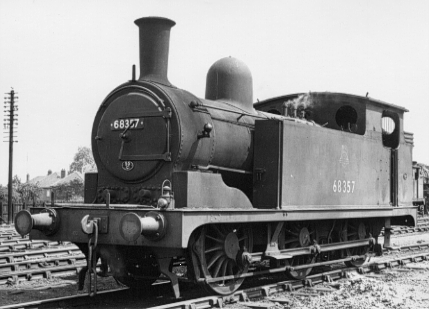The W.Worsdell J73 (NER Class L) 0-6-0 Tank Engines

The Class L locomotives, were Wilson Worsdell's first design for the North Eastern Railway's (NER). Intended for use on the Redheugh and Quayside banks on either side of the Tyne, these were significantly larger and more powerful than the existing J71 shunting locomotives. As a specialised design, only one batch of ten locomotives was built in 1891-2.
The J73s had Joy valve gear - disliked by Wilson Worsdell, but favoured by his brother T.W. Worsdell, the NER's previous Locomotive Superintendent. T.W. Worsdell remained at the NER as a consultant for two years, and he appears to have influenced the choice of valve gear. Alternatively, it may have been a natural choice as most of Darlington's recent locomotives had Joy valve gear.
Compared to the J71s, the J73s had larger cylinders, boiler, and grate area. The cylinders were increased from 16in diameter to 19in diameter. The grate area was increased by 40% and the boiler's total heating surface was increased by 50%. The boiler was similar to that used on the existing F8 2-4-2T (NER Class A) locomotives, and it would be used on both of W. Worsdell's next designs (the G5 0-4-2T and J24 0-6-0 classes). As well as the boiler, these two classes shared a number of other parts with the J73s.
The J73s remained virtually unchanged during their lives, although the boiler designs were modified. Late in NER ownership, the number of tubes were reduced from 206 to 205, resulting in a small reduction of heating area from 1097 sq.ft. to 1093 sq.ft. In 1930, Diagram 69 boiler construction was modified. Instead of three rings, the barrel was made from a single rolled plate. The tubes were also reduced 199, and the total heating surface was reduced to 1069 sq.ft. This modified boiler design eventually found its way on the J73s, but only in the form of secondhand transfers.
In 1937, the Diagram 69 design was modified to become Diagram 69A. The number of tubes was increased back to 205, and the dome was moved back about 1ft 8in. The rolled construction was kept. No. 552 was the first J73 to receive a Diagram 69A boiler in November 1942. At least one J67 (No. 547) never received a Diagram 69A boiler.
The original Ramsbottom safety valves were eventually replaced with Ross pop valves, but this was not until after 1942. The Ross pop valves do not appear to have required the steam shielding devices that the smaller J71s and J72s required.
The J73s were initially used on the steeper banks on either side of the Tyne. They were particularly noted on the Redheugh incline that led from Dunston up to Gateshead, and on the Quayside branch on the north bank. The J73s were re-allocated when the Quayside branch was electrified. At Grouping (1923), the J73s were allocated to Ferryhill (5), Tyne Dock (2), Pelton Level (2), and Heaton (1). The Ferryhill locomotives were mainly used pushing east-bound coal trains up Kelloe Bank from Coxhoe Bridge to Trimdon. This was a part of an older route that went via Castle Eden to East Hartlepool. Later on, the coal trains would run in the opposite direction, taking the former Clarence route through Norton.
In 1937, a large number of J71s were withdrawn from the Hull area. These were replaced by a number of larger locomotives to work timber traffic on Hull Docks. These locomotives included five of the J73s. World War 2 had a significant impact on Hull Docks traffic, and three of the J73s were transferred in 1940 to Selby to work the Gascoigne Wood marshalling yard. At Nationalisation (1948), the J73s were allocated to Alexandra Dock (2), Selby (3), West Hartlepool (4), and Tweedmouth (1).
The J73s performed very well and served with an average life of 65 years. Withdrawals did not start until 1955, and the last was withdrawn in 1960.
Technical Details
| Cylinders (x2): | (inside) | 19x24in. |
| Motion: | Joy | |
| Valves: | Slide | |
| Boiler: | Diameter (max): | 4ft 3in |
| Length: | 10ft 3in | |
| Boiler Pressure: | 160psi | |
| Diagram No: | 69 | |
| Heating Surface: | Total: | 1093 sq.ft. |
| Firebox: | 98 sq.ft. | |
| Tubes: | 995 sq.ft. (205x 1.75in dia.) | |
| Grate Area: | 15.6 sq.ft. | |
| Wheels: | 4ft 7.25in | |
| Total Wheelbase: | 15ft 8in | |
| Tractive Effort: | (at 85%) | 21,320 lb |
| Length: | 31ft 8in | |
| Weight: | 46t 15cwt | |
| Max. Axle Load: | 18t 6cwt | |
| Water Capacity: | 1000 gallons | |
| Coal Capacity: | 2t 10cwt |
Preservation
None of the J73s survived into preservation.
Models
Furness Railway Wagon Co have a 7mm (O gauge) model of the J73 in development.
Acknowledgements
Thank you to the P.H. Groom collection for permission to use the above photograph of BR No. 68357 at Selby.